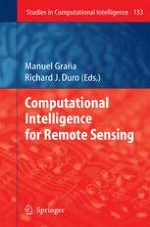2008 | OriginalPaper | Chapter
Neural Networks for Land Cover Applications
Authors : Fabio Pacifici, Fabio Del Frate, Chiara Solimini, William J. Emery
Published in: Computational Intelligence for Remote Sensing
Publisher: Springer Berlin Heidelberg
Activate our intelligent search to find suitable subject content or patents.
Select sections of text to find matching patents with Artificial Intelligence. powered by
Select sections of text to find additional relevant content using AI-assisted search. powered by
Following upon their resurgence as a research topic in the second half of the eighties [1][2], neural networks burst out in the remote sensing community by the end of the same decade when a bunch of investigators started looking at them as an effective alternative to more traditional methods for extracting information from data collected by airborne and spaceborne platforms [3] [4]. Indeed, for researchers used to handle multidimensional data, the possibility of building classification algorithms avoiding the assumptions required by the Bayesian methods on the data probability distributions seemed rather attractive. For the case of parameter retrieval, neural networks owned the advantage of determining the input-output relationship directly from the training data with no need to seek for an explicit modelling of the physical mechanisms, often nonlinear and with poorly understood factors involved [5]. Moreover, it was shown that multilayer feedforward networks formed a class of universal approximators, capable of approximating any real-valued continuous function provided a sufficient number of units in the hidden layer was considered [6]. There were enough reasons to explore the potentialities of such neurocomputational models, also known as associative memory based models, in a wide range of remote sensing applications. This was actually what happened throughout all nineties and, even if with less emphasis, is continuing up to date. Image classification, from SAR imagery to latest hyperspectral data, has probably been one of the most investigated fields in this context. However, the use of neural network for the retrieval of bio-geophysical parameters from remotely sensed data has also played a significant role. In particular, the synergy between these algorithms and RT (Radiative Transfer) electromagnetic models represented a new and effective way to replace the empirical approaches, often based on limited seasonally or regionally data, hence with little generalization capabilities. The use of the RT models is twofold. They can help in the sensitivity analysis of the electromagnetic quantities to the bio-geophysical parameters. They can be exploited for the synthetic generation of training data in case of a lack of experimental data and ground-truth. The combined use of electromagnetic models and neural networks is a topic treated in many published studies taking into account the most diverse applicative scenarios: from the inversion of radiance spectra to infer atmospheric ozone concentration profiles [7], to the retrieval of snow parameters from passive microwave measurements [8] or to the estimation of sea water optically active parameters from hyperspectral data [9], just to mention one case for the three main different domains: atmosphere, earth surface and ocean. As far as the network topology is concerned, MLP probably are on the top of the authors preference ranking, but the choice is widely spread over the numerous alternatives which include RBF (Radial Basis Function), recurrent architectures, as well as the Kohonen SOM [10] if we focus on the unsupervised image classification field. Such an extensive research activity confirmed that neural networks, besides representing a new and easy way of machine learning, possess particularly interesting properties, such as the capability of capturing subtle dependencies among the data, an inherent fault tolerance due to their parallel and distributed structure, a capability of positively merging pieces of information stemming from different sources. Only advantages? Obviously not. The conventional backpropagation learning algorithm can be stuck in a local minimum. Moreover, the choice of network architecture (i.e. number of hidden layers and nodes in each layer), weight initialization and number of iterations required for training may significantly affect the learning performance. Addressing these issues is one of the dominant themes of the current research. Some authors [11] suggest that SVM (Support Vector Machines) may reach in terms of accuracy performances similar to those obtainable by means of neural networks without suffering from the problem of local minima and with limited effort required for architecture design. Other authors [12] remain focused on neural models, aiming at automating the selection of the parameters characterizing the algorithm or searching for improvements in the learning procedures. A different ongoing line of research is more sensitive to the opportunities that should be provided by the data of the last generation EO (Earth Observation) missions. Hence it is more dedicated to exploit the aforementioned neural networks potentialities for more complex applications [13][14]. A couple of interesting examples belonging to this area of research will be illustrated in section 11.3 of this chapter, while section 11.2 recalls some theoretical aspects about neural models.
